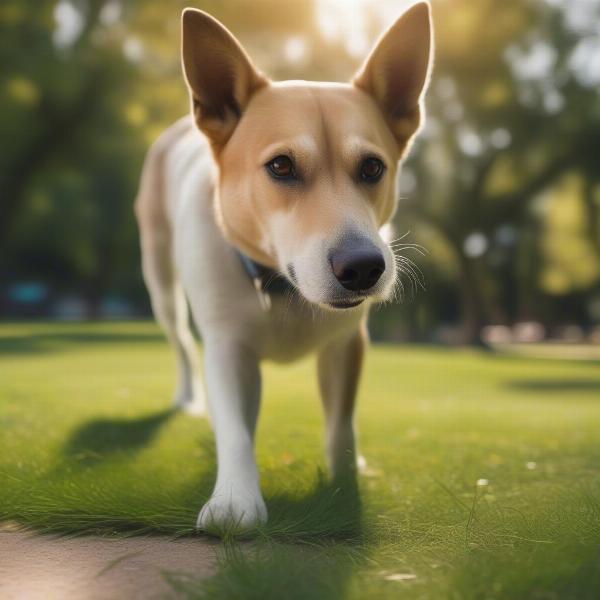Dog speedometer isn’t about a gadget attached to your furry friend, but understanding the various speeds your dog uses to communicate and navigate the world. From a leisurely stroll to a full-blown sprint, each pace reveals insights into your dog’s mood, needs, and even potential health concerns. Knowing how to interpret these speeds is crucial for responsible dog ownership, fostering a stronger bond, and ensuring your dog’s well-being.
The Many Gears of a Dog’s Speedometer
Just like cars, dogs have different “gears” when it comes to their movement. Understanding these paces is key to understanding your dog’s communication and ensuring their safety and happiness.
The Slow Stroll: Sniffing and Exploring
The slowest pace on the dog speedometer is the sniff-and-stroll. This isn’t just about leisurely movement; it’s a crucial part of how dogs explore and understand their environment. Their noses are incredibly powerful, picking up a wealth of information from the world around them. Allowing your dog ample time to sniff on walks provides essential mental stimulation and enrichment.
 Dog Sniffing Grass
Dog Sniffing Grass
The Trot: Purposeful Movement
A trot indicates purposeful movement. Your dog is likely heading somewhere specific, perhaps responding to a call or chasing a squirrel. This pace is efficient and allows them to cover ground quickly without expending excessive energy.
The Canter: Playful Energy
The canter is where playfulness truly shines. This bouncy, three-beat gait often precedes a burst of speed or playful interaction. It’s a sign of excitement and anticipation, often seen when dogs are engaging in games like fetch or chase.
The Gallop: Full Speed Ahead!
The gallop is the top speed on the dog speedometer. This four-beat gait allows dogs to reach impressive speeds, whether they’re chasing a ball, racing another dog, or simply enjoying the thrill of running free. Ensuring your dog has safe opportunities to gallop is important for their physical and mental well-being.
Reading Your Dog’s Speed: More Than Just Pace
While pace is a key indicator, observing your dog’s overall body language, tail wags, ear position, and vocalizations will paint a more complete picture of their emotional state. A slow walk with a tucked tail and lowered ears might indicate fear or anxiety, while a trot with a wagging tail and perked ears suggests excitement or anticipation.
Recognizing Potential Problems: When Speed Changes
Sudden changes in your dog’s usual pace can sometimes signal underlying health issues. For instance, a dog that suddenly slows down or shows reluctance to run may be experiencing pain or discomfort. If you notice any significant changes in your dog’s speed or gait, consult your veterinarian for a thorough evaluation.
Conclusion: Tuning into Your Dog’s Speedometer
Understanding your dog’s speedometer – their various paces and the associated body language – is a crucial part of responsible dog ownership. By learning to interpret these signals, you can better understand your dog’s needs, enhance your bond, and ensure their overall well-being. Observing your dog’s speed, along with their overall demeanor, offers valuable insights into their physical and emotional state. This knowledge empowers you to provide the best possible care for your canine companion.
FAQs
- Why does my dog sniff so much on walks? Sniffing is a crucial way for dogs to explore and understand their environment. It provides them with essential mental stimulation.
- Is it important to let my dog run at full speed sometimes? Yes, providing safe opportunities for your dog to gallop is important for their physical and mental well-being.
- What should I do if my dog suddenly changes its usual pace? Consult your veterinarian for a thorough evaluation as it could be a sign of an underlying health issue.
- How can I tell if my dog is happy with its pace? Look for relaxed body language, a wagging tail, and perked ears. A tense body, tucked tail, or lowered ears may suggest discomfort or fear.
- Does my dog’s breed affect its speed? Yes, some breeds are naturally faster than others due to their size, build, and breeding history.
- How can I encourage my dog to walk at a slower pace? Using positive reinforcement training and rewarding calm behavior can help. A comfortable harness and leash can also make walks more enjoyable.
- Is it normal for older dogs to slow down? Yes, as dogs age, it’s natural for them to slow down and have less energy. Regular exercise is still important, but it should be adapted to their age and abilities.
About ILM Dog: ILM Dog is your go-to resource for expert advice on all aspects of dog care, from breed selection and puppy care to senior dog health and training tips. We are passionate about providing dog owners with reliable, practical information to help them build strong, fulfilling relationships with their furry companions. For all your dog-related queries, reach out to our team of experts via email at [email protected] or call us at +44 20-3965-8624. We’re here to help!